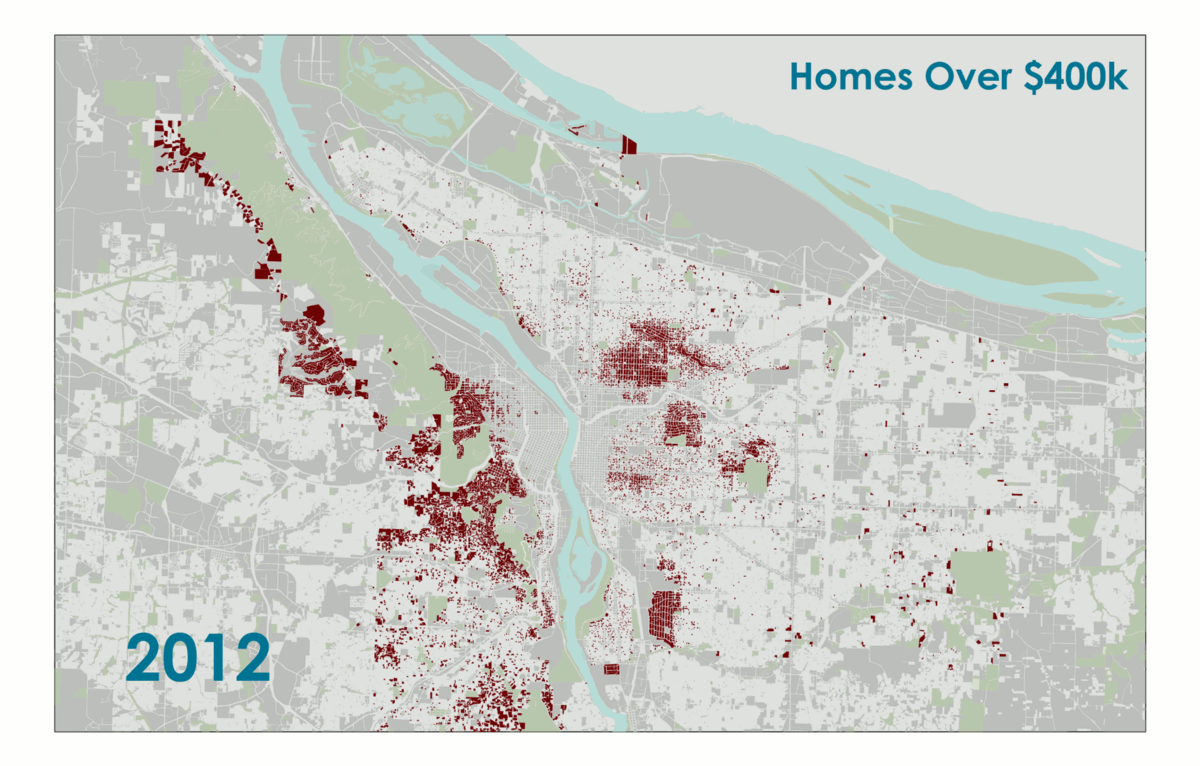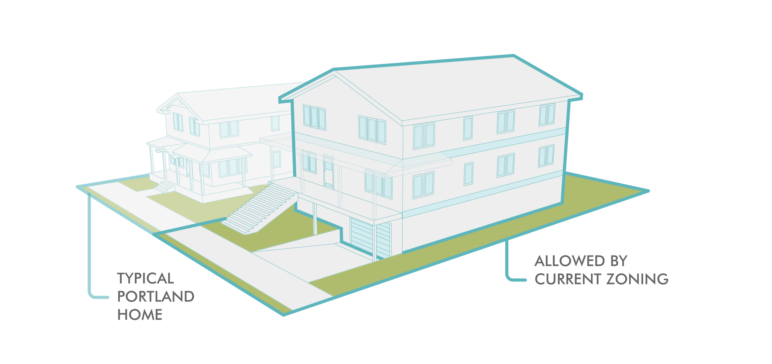Editor’s note: This article combines and adapts three articles by the Portland for Everyone coalition’s Michael Andersen. See the originals on this blog, and learn more about the group here. Portland’s approach shares similarities with the Seattle Housing Affordability and Livability Agenda recommendation to allow small duplexes and triplexes in single-family zones without letting property owners erect buildings larger than currently zoned.
Growing cities across the US and Canada are grappling with the challenges of displacement and affordability in their housing markets, and many of them are looking to Cascadia’s innovative cities for answers. Portland, the smallest of Cascadia’s three major metropolitan areas, has perhaps one of its biggest and best ideas: the “residential infill project.”
So, what’s in the Rose City’s innovative plan? First, let’s take a closer look at the city’s growing affordability problem.
The rapid spread of out-of-reach home prices in Portland

Every month, Portland’s most beloved neighborhoods are moving further beyond the reach of typical homebuyers.
Property tax records show the alarming spread, over the last four years, of homes valued at $400,000 or more—enough to make them unaffordable to 59 percent of Portlanders, according to the latest Census estimates.
As the map above makes obvious, the wave of price increases isn’t simply tied to construction or demolition. It’s hitting new houses and old ones, in neighborhoods that are adding homes and in neighborhoods where adding homes isn’t allowed.
What does this look like on the street? Well, here’s what it looks like in my own neighborhood:

This house is 1,700 square feet on SE 75th Avenue in Montavilla. Last year, it sold for $247,500—a $1,200 monthly mortgage payment. After the really nice remodel you see here, it’s going for $549,000. Profitable for the flipper, but the only thing this project did for the city was replace one middle-class family with one rich one.
But the really odd thing is that on this lot, replacing one middle-class family with one rich one is just about the only thing a landowner is legally allowed to do.
When a city gets more desirable but isn’t allowed to add more places for people to sleep, this is what happens: the old homes don’t stay affordable. They just get priced up and up and up.
It seems a little strange, but one of the things Portland needs to do as a city is to prevent that remodel and get more of the city’s capital invested in projects that prevent displacement rather than enable it.
The residential infill project that went before Portland City Council November 9 and will again November 16 is an opportunity to make this happen. It’s a chance for the city to strike an anti-McMansion compromise and shrink the maximum size of new homes (which would reduce demolitions) while also legalizing duplexes, triplexes, and backyard cottages (which would mean that the demolitions that do happen would result in more small homes instead of fewer, huge, expensive ones).
Instead of allowing new single-dwelling homes to look like this:

They’d be allowed to look, for instance, like this (and like several other models noted later in this article):

To be clear, nobody is talking about requiring new homes to look like this. The overwhelming majority of residential homes would still have lots of space and yards of their own. But by making it once again legal to build these small homes in residential areas, Portland would make this an option for people who want something in between an apartment building and a freestanding house, which means fewer people would be competing for apartments and for freestanding homes.
There’s another possibility here: the city might decide to shrink the size of new homes but not make small multiplexes legal.
If that were to happen, it wouldn’t stop developers and landlords from finding ways to make a profit. It would mean that the only way they could make a profit is by replacing poor folks with middle-income folks and middle-income folks with rich folks.

Portlanders have already seen what that would look like, in more and more neighborhoods across the city. But it doesn’t have to be that way, and Portland has a smart plan to combat that trend.
The ‘residential infill project’: Portland’s anti-McMansion recipe

If there’s one thing virtually all Portlanders can agree on, it’s that homes should cost less than they do right now.
There’s a lot of disagreement about how to do this.
But if there’s a second thing that most Portlanders can agree on, it’s that McMansions are dumb.
Knock down a 1920s cottage, build a 2010s behemoth: you just spent half-a-million dollars to replace one home with one home, and you basically paid for it by replacing a middle-class household with a rich one.
The fact that so many people agree this is bad—affordability advocates, historic preservationists, immediate neighbors—is the key to the compromise behind Portland’s residential infill project.
Its basic idea: the city should reduce 1:1 demolitions in much of the city by:
- Greatly reducing the maximum size of new homes, which also reduces the number of demolition projects that turn out to be profitable (and therefore the number of demolitions that happen).
- Re-legalizing midblock duplexes, corner triplexes, and multiple accessory units, which means that when homes are replaced, the new ones will be cheaper and there will be more of them instead of being much larger and more expensive.
According to an analysis by Johnson Economics commissioned by the City of Portland and released last month, the residential infill project would do both of these things:
- The total number of demolitions would drop substantially. But…
- The number of new homes built wouldn’t drop by much because the smaller number of homes that would be demolished would be replaced by multiple smaller, cheaper units—instead of freestanding McMansions.
(Frustratingly, the analysis doesn’t put exact numbers on either of these: the number of demolitions reduced or the number of new homes added. But these numbers ought to be calculable. If we can find this answer, we’ll write about it on the Portland for Everyone blog.)
Here’s another city graphic that shows some options that could be built instead of McMansions:

Today, McMansions are totally legal to build, but none of the homes above is. The city’s proposal would reverse this.
Front yards would need to be larger, and more on-street parking would be preserved
Under the city’s latest proposal, also released Tuesday, all of these new buildings would also be subject to other new rules about building height and distance from the street. Developers would have to build farther from the street…

…except in situations where a neighboring house is already close to the street. (In which case, the thinking is presumably “no harm, no foul.”)
Another proposal in the residential infill project would create more tree-lined streets in the future and preserve more on-street parking space. One-car driveways, after all, don’t really increase the number of parking spaces because each one eliminates a curbside space.

The city’s proposal is to maximize parking efficiency by legalizing alley-facing driveways and shared driveways leading behind the house.

How much would prices of newly built homes go down?
There are lots of things the city’s proposal does not accomplish. Newly built duplexes would be a lot cheaper than newly built McMansions—check out the price estimates in the green box below.

But $431,000 is not exactly cheap, even for a brand-new home.
“You need a four-plex to get at least one of those units into the $100,000 to $150,000 range,” said Garlynn Woodsong, a northeast Portland neighborhood advocate who has developed a four-plex and a three-plex out of old buildings in his area.
Danell Norby, who represents advocacy coalition Anti-Displacement PDX on the residential infill project, said the project doesn’t do as much as it could to increase the number of homes in Portland.
“On the one hand, lower rates of redevelopment may increase the likelihood of longer-term residents staying in their neighborhoods, and the lower per-unit price is of course a good thing,” she wrote in an email. “But even if home prices are lower than they would otherwise be, lower-income families are still at risk of being outbid. There’s tons of competition, and we need more housing.”
Norby suggested expanding the focus area to include all of Portland’s residential land instead of the approximately two-thirds of it proposed by the city.
Where would demolitions happen?
Below is a map of where demolitions will be most likely over the next 20 years without the residential infill project. Areas marked in red are most likely to see demolition because those are the places where land is relatively valuable compared to the buildings currently occupying it. (Non-colored areas are outside the city’s proposed residential infill project area, so they weren’t analyzed here. Mostly that’s because the other land isn’t zoned residential.)
Note, for example, that much of Cully, St. Johns, and southwest Portland would gradually be replaced by McMansions:

Here’s where demolitions would be most likely under the city’s proposal with the residential infill project, according to the economic analysis. Note that there are still lots of red (higher-demolition) areas, but they’re less intense. And there are more areas of solid blue, the least likely to see redevelopment. So neighborhoods like Cully, St. Johns, and southwest Portland would still see most of the change, but they’d see notably less:

In an interview last month, the economist who did the analysis above called the city’s proposal “an interesting compromise.”
“You’ll be knocking down less buildings,” Jerry Johnson said. “You’ll get more units, and they’ll be at a lower price point, generally.”
Johnson said that when he got the assignment from the city, he wasn’t sure what his model would turn up and wasn’t even sure what the city hoped his analysis would conclude.
“It’s rare that I’m involved in one of these processes where I don’t sort of know… what’s trying to be accomplished,” Johnson said. Then he laughed. “Heck, maybe it’s better. They just ask me a question and I give them an answer.”
What sort of homes might Portland re-legalize? Check it out
So, it’s clear that Portland faces serious affordability and displacement challenges, as discussed above. And Portlanders, in their plucky, problem-solving, community-minded way, are eager to find solutions together. Facing the spread of startlingly expensive housing across Portland, city officials are considering re-legalizing certain types of housing in many of its residential areas.
Buildings like this triplex:

But some Portlanders are very, very upset about this idea. In August, one group marched through Southwest Portland with preprinted signs saying “Don’t Rezone Us” (DRU). Margaret Davis of United Neighborhoods for Reform (UNR) described the concept as “rezoning huge swaths of the city.”
The building on the right in the above image is what they’re talking about.
And whether or not groups like DRU and UNR like it (or even know about it), there are lots of buildings like it scattered through Portland’s neighborhoods already. Notably, though, almost none of them is new, because in 1959 the city made it illegal to build any more triplexes in most Portland residential areas.
So what is currently legal to build instead of triplexes? This:

To be fair, the 6,000-square-foot McPalace on the right is the largest that could possibly be built, not what is in fact currently being built. Last time the city checked (in 2013), most new homes on standard residential lots were between 2,500 and 4,000 square feet, and it’s unlikely that they’ve shrunk since.
By comparison, the “typical Portland home” pictured on the left, hypothetically built in 1920, is 1,700 square feet (not counting that cool porch).
The city’s most recent proposal is to cap all new buildings on standard residential lots at 2,500 square feet total. This would prevent the largest 60 percent of new single-family homes—the McMansions, in other words—from ever being built.
Houses up to 2,500 square feet would still be allowed, more than enough room to house the smaller or childless families common today and even more common in cities. Here’s what the proposed new maximum would look like:

Again, the economic study noted above concluded that this new maximum on the size of homes would reduce the number of demolitions in the city over the next 20 years. That’s because, with smaller maximum home sizes, demolitions would become less profitable. Mostly, this would happen by reducing the number of 1:1 demolitions (McMansions) and 1:2 demolitions (“skinny houses”).
No, legalizing triplexes would not mean most houses would suddenly be knocked down to build a triplex
This seems to be the fear expressed by people like Davis or Midge Pierce of the Southeast Examiner (another vocal critic), and it’s understandable. But the key reason why this wouldn’t happen, according to the economic study, is the new cap on building size.
For a demolition to occur, one simple thing needs to be true: a building needs to be more valuable as vacant land than it is as a building. Here’s the algebra of demolition:

If that formula isn’t true, then demolition won’t happen.
By shrinking the size of new buildings, Portland would greatly reduce those buildings’ potential sale price and therefore the number of demolitions that are viable. The other difference is that when demolitions do occur, the city’s proposal would ensure that instead of replacing one small home with one huge home, they’d replace one small with two or three small homes—reducing displacement instead of enabling it.
To actually reduce home prices, we need to legalize small homes and block big ones
Unfortunately, simply reducing demolition wouldn’t do anything to help Portland’s affordability problem, which is one of the goals of the residential infill project. If all building in the city stopped tomorrow, it would only accelerate the process by which tens of thousands of little old bungalows are gradually becoming as expensive as McMansions.
That’s why the city is also considering re-legalizing duplexes in residential zones up to exactly the same size as new single-family homes:

The city might also legalize backyard cottages on the same lot as a duplex, as long as their combined square footage is no more than 3,250 square feet (that includes a 15 percent bonus for a cottage):

Another idea that isn’t in the city’s latest proposal—but that could be—would be to make it legal to put a fourth unit on a lot, as long as at least one of the four is both affordable to lower-income households and accessible to people with disabilities.

Or the city could take a further step toward preventing demolition by making it legal to internally divide an old building into multiple homes. There could be lots of options for this, as long as the structure and any on-site trees were preserved:

Of these options, only the last one—the four-plex with a cost-control requirement—would directly create a new home that’s affordable to lower-income Portlanders. Again, this isn’t part of the city’s latest proposal.
The other ideas above do still advance affordability, though:
- They’d slow price increases citywide by creating additional homes that give middle-class people somewhere to move that doesn’t displace a person or family with lower income or wealth.
- They’d make it possible for more homes in Portland’s residential zones to be within reach of the city’s middle class.
Most Portlanders would probably agree that both of these goals are good. But most Portlanders probably want people with lower incomes and wealth to benefit from housing policy changes, too.
Portland for Everyone published a followup article that explores the Residential Infill Project’s potential for Portland households with lower incomes and wealth.
Portland for Everyone supports abundant, diverse, affordable housing. Its blog, from which Sightline Institute gained permission to repost these articles, is a reported effort to explore the ways to achieve those goals. You can learn how to influence the residential infill project here.


Comments are closed.